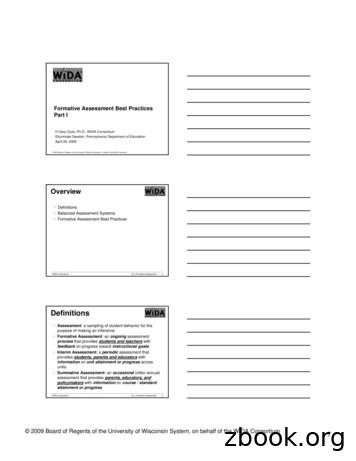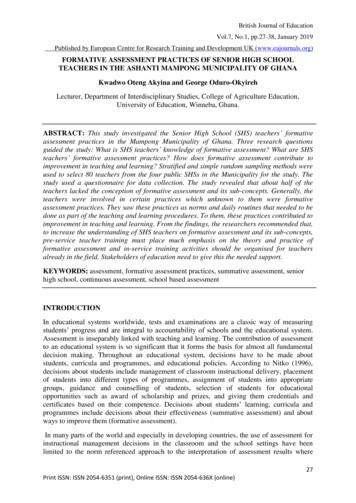Formative Assessment Best Practices
Formative Assessment Best PracticesPart IH Gary Cook, Ph.D., WIDA ConsortiumElluminate Session, Pennsylvania Department of EducationApril 28, 2009 2009 Board of Regents of the University of Wisconsin System, on behalf of the WIDA ConsortiumOverviewDefinitionsBalanced Assessment SystemsFormative Assessment Best PracticesWIDA ConsortiumELL Formative Assessment2DefinitionsAssessment: a sampling of student behavior for thepurpose of making an inferenceFormative Assessment: an ongoing assessmentprocess that provides students and teachers withfeedback on progress toward instructional goalsInterim Assessment: a periodic assessment thatprovides students, parents and educators withinformation on unit attainment or progress acrossunits.Summative Assessment: an occasional (often annual)assessment that provides parents, educators, andpolicymakers with information on course / standardattainment or progressWIDA ConsortiumELL Formative Assessment3 2009 Board of Regents of the University of Wisconsin System, on behalf of the WIDA Consortium1
Balanced Assessment room-basedStandards&TargetsPeriodic, School and/orDistrict-BasedWIDA ConsortiumELL Formative Assessment4“To many of today’s teachers, assessmentis synonymous with high-stakesstandardized tests. But there is an entirelydifferent kind of assessment that canactually transform teaching and learning.”Margaret HeritageWIDA ConsortiumELL Formative Assessment5Types of FormativeAssessmentsSpontaneous (impromptu)Immediate. While teaching, a teacher sees a misunderstanding ormisconception and immediately addresses it.Not a planned activity. While not planned, a variety of tools are atthe teacher’s disposal to formatively assess students, e.g., reteaching, change in instructional venue, asking another student toprovide an example.PlannedDeveloped before a lesson. The teacher has a learning target orlearning outcome in mind and prepares an assessment toexamine it.Planned feedback mechanism. The outcome for this assessmentin planned ahead of time.WIDA ConsortiumELL Formative Assessment6 2009 Board of Regents of the University of Wisconsin System, on behalf of the WIDA Consortium2
Formative Assessment CycleWIDA ConsortiumELL Formative Assessment7Examples SpontaneousQ & A during lessonsObserving students during anactivityResponding in to students’impromptu conversations Common sequencing: Measuring,Feedback, Goals, InstructionPlannedShort Tests and QuizzesHomework exercisesObservation protocolsIn class assignments or activitiesIn or out of class projects (e.g.,science fair, essay)Simulation (role play) activitiesChecklistsStudent ConferencePeer and self assessmentCommon sequencing: Goals, Instruction,Measuring, FeedbackELL Formative Assessment8ELL Formative Assessment9Formative AssessmentBest PracticesWIDA Consortium 2009 Board of Regents of the University of Wisconsin System, on behalf of the WIDA Consortium3
Technically SoundValid: formative assessments measure importantconcepts, skills, and ideasAligned to instructional goalsConnected to meaningful learning targets & standardsFocused on student learning needsAre appropriate measuresReliable: formative assessments provide consistentinformationMeans the same thing when used over againProvides actionable results for both teachers AND studentsWIDA ConsortiumELL Formative Assessment10Embedded, OngoingConnected with CurriculumPart of the instructional process, not distinct from itNot “add-ons” to instructionConnected with lesson plans, learning goals, and meaningfulstandardsNot “one-time-wonders”Designed to be ongoing, iterative, “organic”A process not an eventWIDA ConsortiumELL Formative Assessment11Learning GoalsConnected to language learning goals and targetsAligned to standards & curriculumFocused on student learningClear and explicit in what students are supposed to learnSupport instructional goalsOrganized to appropriate learning progressionsAppropriately sequenced language functions, vocabulary andgrammarAppropriate measures for students’ current language proficiencyWIDA ConsortiumELL Formative Assessment12 2009 Board of Regents of the University of Wisconsin System, on behalf of the WIDA Consortium4
ExamplesFor teachersRubrics, checklists, and rating scales have examples of each typeof performance.Teachers have a concept of what performance will look like, and ifpossible.When possible, teachers collect examples of “good” student work.For studentsStudents should have access to the rubrics, checklists, or ratingscales used to evaluate their work AND training on how tointerpret them for themselves.Student should have examples of what “good work” looks like.WIDA ConsortiumELL Formative Assessment13Current SkillsIdentify, with sufficient clarity, students’ current languageabilities and skills:Vocabulary knowledgeGrammatical controlComprehension skillsCommunication skillsDiscourse capabilities (e.g., functional language abilities)Highlight current skills to studentsWIDA ConsortiumELL Formative Assessment14Highlight Future GoalsPoint, with sufficient clarity, to students’ future languagegoalsIdentify the “next step” in students’ language learningprogressionVocabulary knowledgeGrammatical controlComprehension skillsCommunication skillsDiscourse capabilities (e.g., functional language abilities)Highlight next steps to studentsWIDA ConsortiumELL Formative Assessment15 2009 Board of Regents of the University of Wisconsin System, on behalf of the WIDA Consortium5
IntegratedFormative assessments are associated with otherassessments used at the school, district and state level.WIDA ConsortiumELL Formative Assessment16DynamicFormative assessments must fit into classroom realitiesand be easy to administer and score.WIDA ConsortiumELL Formative Assessment17ELL Formative Assessment18Rigorous PDGood formative assessmentprograms are associated withrigorous professionaldevelopment opportunities.A variety of PD approachesare also use, e.g.,workshops, mentoring.WIDA Consortium 2009 Board of Regents of the University of Wisconsin System, on behalf of the WIDA Consortium6
WorksheetELL Formative Assessment19Good ReferencesHeritage, M. (October 2, 2007). Formative Assessment: Whatdo teachers need to know and do? Phi Delta Kappan, vol.89:2, pp.140-145.Margaret HeritageMcMillan, J.H. (2007). Formative Classroom Assessment:Theory into practice (ed.). NY: Teachers College Press.Popham, W. J. (2008). Classroom assessment: What teachersneed to know (5th ed.). Boston: Allyn and Bacon.Assessment Training Institute. www.assessmentinst.com/WIDA ConsortiumELL Formative Assessment20 2009 Board of Regents of the University of Wisconsin System, on behalf of the WIDA Consortium7
Formative Assessment Best Practices Part I H Gary Cook, Ph.D., WIDA Consortium Elluminate Session, Pennsylvania Department of Education April 28, 2009 WIDA Consortium ELL Formative Assessment 2 Overview Definitions Balanced Assessment Systems Formative Assessment Best Practices ELL Formative Assessment 3 Definitions
--1-- Embedded Formative Assessment By Dylan Wiliam _ Study Guide This study guide is a companion to the book Embedded Formative Assessment by Dylan Wiliam. Embedded Formative Assessment outlines what formative assessment is, what it is not, and presents the five key strategies of formative assessment for teachers to incorporate into their
Performance Assessment Score Feedback Formative 1 Date . Formative 2 Date : Formative 3 Date . Formative 4 Date : Formative 5 Date . Formative 6 Date : Summative Date Implements learning activities aligned to chosen standards and incorporates embedded formative assessment. Clearly conveys objectives in student-friendly language so that the
assessment. In addition, several other educational assessment terms are defined: diagnostic assessment, curriculum-embedded assessment, universal screening assessment, and progress-monitoring assessment. I. FORMATIVE ASSESSMENT . The FAST SCASS definition of formative assessment developed in 2006 is “Formative assessment is a process used
assessment professional learning system. They are stepping stones along the path. Part I. Learn About Formative Assessment 1.1 Inventory your comprehensive assessment system. 1.2 Clear up misconceptions about formative assessment. Part II. Plan For Formative Assessment 2.1 Identify elements of formative practice that you do well and those you
FORMATIVE ASSESSMENT Formative assessment is any assessment that is used to improve teaching and learning. Assessment is a three-step process by which evidence is collected, interpreted and used. Best-practice formative assessment uses a rigorous approach in which each step of the
An assessment practice is only truly “formative” if the data is used to inform instructional practice and provide support to ensure student success. To learn more about formative assessment practices, visit the D PI Formative Assessment website, or utilize the Formative Assessment Professional Learning Modules .
formative assessment. Theoretical framework of the study Looking for a working description for formative assessment alongside summative assessment in the school setting, Madison-Harris, Muoneke and Times (2012) reviewed series of literature on formative assessment and concluded that "it is a systematic, continuous process
‘Tom Sawyer!’ said Aunt Polly. Then she laughed. ‘He always plays tricks on me,’ she said to herself. ‘I never learn.’ 8. 9 It was 1844. Tom was eleven years old. He lived in St Petersburg, Missouri. St Petersburg was a town on the Mississippi River, in North America. Tom’s parents were dead. He lived with his father’s sister, Aunt Polly. Tom was not clean and tidy. He did not .























